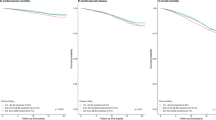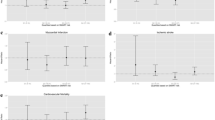Abstract
The prognostic importance of baseline and serial glycated hemoglobin (HbA1c) changes for cardiovascular outcomes is still debated. We aimed to evaluate it in 620 high-risk individuals with type 2 diabetes (mean age 60.4 years, 37 % males, 55 % Caucasians). Patients had HbA1c levels measured at study entry and serially during follow-up. Primary end points were total cardiovascular events (CVEs), major CVEs (non-fatal myocardial infarctions and strokes plus cardiovascular deaths) and all-cause mortality. Cardiovascular and non-cardiovascular mortalities were secondary end points. HbA1c was evaluated either as a continuous variable and categorized at clinically relevant cutoffs. Multivariate Cox regressions assessed the associations with end points. After a median follow-up of 6.6 years, 125 total CVEs occurred (90 major CVEs), and 111 patients died (64 from cardiovascular diseases). After statistical adjustments for other cardiovascular risk factors, baseline and mean first-year HbA1c predicted all end points, except non-cardiovascular deaths; and hazard ratios tended to be higher for mean first year than for baseline HbA1c. Each 1 % (10.9 mmol/mol) increase in mean first-year HbA1c increased 27 % the risk of major CVEs occurrence (95 % CI 11–45 %). Updating HbA1c for values obtained beyond the second year of follow-up did not improve its predictive performance. The cardiovascular protection was observed until HbA1c values lower than 6.5 % (48 mmol/mol). Moreover, the magnitude of HbA1c reduction during the first year of follow-up was predictive of better cardiovascular outcomes, independent of baseline HbA1c levels. In conclusion, better glycemic control, especially during the first year of follow-up, is determinant of better cardiovascular outcomes in high-risk patients with type 2 diabetes, without any detectable lower threshold level of HbA1c.


Similar content being viewed by others
References
Wild S, Roglic G, Green A, Sicree R, King H (2004) Global prevalence of diabetes: estimates for the year 2000 and projections for 2030. Diabetes Care 27:1047–1053
Emerging Risk Factors Collaboration, Seshasai SR, Kaptoge S, Thompson A, Di Angelantonio E, Gao P, Sarwar N et al (2011) Diabetes mellitus, fasting glucose, and risk of cause-specific death. N Engl J Med 364:829–841
Selvin E, Coresh J, Golden SH, Brancati FL, Folsom AR, Steffes MW (2005) Glycemic control and coronary heart disease risk in persons with and without diabetes: the atherosclerosis risk in communities study. Arch Intern Med 165:1910–1916
Andersson C, van Gaal L, Caterson ID, Weeke P, James WP, Coutinho W et al (2012) Relationship between HbA1c levels and risk of cardiovascular adverse outcomes and all-cause mortality in overweight and obese cardiovascular high-risk women and men with type 2 diabetes. Diabetologia 55:2348–2355
Zhao W, Katzmarzyk PT, Horswell R, Wang Y, Johnson J, Hu G (2014) HbA1c and coronary heart disease risk among diabetic patients. Diabetes Care 37:428–435
Selvin E, Marinopoulos S, Berkenblit G, Rami T, Brancati FL, Powe NR, Golden SH (2004) Meta-analysis: glycosylated hemoglobin and cardiovascular disease in diabetes mellitus. Ann Intern Med 141:421–431
Zhang Y, Hu G, Yuan Z, Chen L (2012) Glycosylated hemoglobin in relationship to cardiovascular outcomes and death in patients with type 2 diabetes: a systematic review and meta-analysis. PLoS One 7:e42551
UK Prospective Diabetes Study (UKPDS) Group (1998) Intensive blood-glucose control with sulphonylureas or insulin compared with conventional treatment and risk of complications in patients with type 2 diabetes (UKPDS 33). Lancet 352:837–853
UK Prospective Diabetes Study (UKPDS) Group (1998) Effect of intensive blood-glucose control with metformin on complications in overweight patients with type 2 diabetes (UKPDS 34). Lancet 352:854–865
Action to Control Cardiovascular Risk in Diabetes Study Group, Gerstein HC, Miller ME, Byington RP, Goff DC Jr, Bigger JT, Buse JB et al (2008) Effects of intensive glucose lowering in type 2 diabetes. N Engl J Med 358:2545–2559
ADVANCE Collaborative Group, Patel A, MacMahon S, Chalmers J, Neal B, Billot L, Woodward M et al (2008) Intensive blood glucose control and vascular outcomes in patients with type 2 diabetes. N Engl J Med 358:2560–2572
Duckworth W, Abraira C, Moritz T, Reda D, Emanuele N, Reaven PD, VADT Investigators et al (2009) Glucose control and vascular complications in veterans with type 2 diabetes. N Engl J Med 360:129–139
Holman RR, Paul SK, Bethel MA, Matthews DR, Neil HA (2008) 10-year follow-up of intensive glucose control in type 2 diabetes. N Engl J Med 359:1577–1589
Ray KK, Seshasai SR, Wijesuriya S, Sivakumaran R, Nethercott S, Preiss D et al (2009) Effect of intensive control of glucose on cardiovascular outcomes and death in patients with diabetes mellitus: a meta-analysis of randomised controlled trials. Lancet 373:1765–1772
Kelly TN, Bazzano LA, Fonseca VA, Thethi TK, Reynolds K, He J (2009) Systematic review: glucose control and cardiovascular disease in type 2 diabetes. Ann Intern Med 151:394–403
Hemmingsen B, Lund SS, Gluud C, Vaag A, Almdal TP, Hemmingsen C, Wetterslev J (2013) Targeting intensive glycaemic control versus targeting conventional glycaemic control for type 2 diabetes mellitus. Cochrane Database Syst Rev 11:CD008143
Yudkin JS, Richter B, Gale EA (2010) Intensified glucose lowering in type 2 diabetes: time for a reappraisal. Diabetologia 53:2079–2085
Ferguson LD, Sattar N (2013) Reducing cardiovascular disease risk in type 2 diabetes: is the focus on glycaemia warranted? Diabetes Obes Metab 15:387–391
Salles GF, Leite NC, Pereira BB, Nascimento EM, Cardoso CR (2013) Prognostic impact of clinic and ambulatory blood pressure components in high-risk type 2 diabetic patients: the Rio de Janeiro Type 2 Diabetes Cohort Study. J Hypertens 31:2176–2186
Cardoso CR, Leite NC, Ferreira MT, Salles GF (2013) Prognostic impact of aortic stiffness in high-risk type 2 diabetic patients: the Rio de Janeiro Type 2 Diabetes Cohort Study. Diabetes Care 36:3772–3778
Cardoso CR, Marques CE, Leite NC, Salles GF (2012) Factors associated with carotid intima-media thickness and carotid plaques in type 2 diabetic patients. J Hypertens 30:940–947
American Diabetes Association (2005) Standards of medical care in diabetes. Diabetes Care 28(suppl 1):S4–S36
Stratton IM, Adler AI, Neil HA, Matthews DR, Manley SE, Cull CA et al (2000) Association of glycaemia with macrovascular and microvascular complications of type 2 diabetes (UKPDS 35): prospective observational study. BMJ 321:405–412
Currie CJ, Peters JR, Tynan A, Evans M, Heine RJ, Bracco OL et al (2010) Survival as a function of HbA(1c) in people with type 2 diabetes: a retrospective cohort study. Lancet 375:481–489
Landman GW, van Hateren KJ, Kleefstra N, Groenier KH, Gans RO, Bilo HJ (2010) The relationship between glycaemic control and mortality in patients with type 2 diabetes in general practice (ZODIAC-11). Br J Gen Pract 60:172–175
Khunti K, Weston C, Gholap N, Molokhia M, Paul S, Millett C et al (2013) All-cause mortality in relation to glycated haemoglobin in individuals with newly diagnosed type 2 diabetes: a retrospective cohort study. Br J Diab Vasc Dis 13:22–30
Greenfield S, Billimek J, Pellegrini F, Franciosi M, De Berardis G, Nicolucci A, Kaplan SH (2009) Comorbidity affects the relationship between glycemic control and cardiovascular outcomes in diabetes: a cohort study. Ann Intern Med 151:854–860
Riddle MC, Ambrosius WT, Brillon DJ, Buse JB, Byington RP, Cohen RM, Action to Control Cardiovascular Risk in Diabetes Investigators et al (2010) Epidemiologic relationships between A1C and all-cause mortality during a median 3.4-year follow-up of glycemic treatment in the ACCORD trial. Diabetes Care 33:983–990
Skyler JS, Bergenstal R, Bonow RO, Buse J, Deedwania P, Gale EA et al (2009) Intensive glycemic control and the prevention of cardiovascular events: implications of the ACCORD, ADVANCE, and VA diabetes trials: a position statement of the American Diabetes Association and a scientific statement of the American College of Cardiology Foundation and the American Heart Association. Circulation 119:351–357
Inzucchi SE, Bergenstal RM, Buse JB, Diamant M, Ferrannini E, Nauck M et al (2012) Management of hyperglycaemia in type 2 diabetes: a patient-centered approach. Position statement of the American Diabetes Association (ADA) and the European Association for the Study of Diabetes (EASD). Diabetes Care 35:1364–1379
American Diabetes Association (2014) Standards of medical care in diabetes. Diabetes Care 37(suppl 1):S14–80
Acknowledgments
This study was supported by grants from Conselho Brasileiro de Desenvolvimento Científico e Tecnológico (CNPq) and Fundação Carlos Chagas Filho de Amparo à Pesquisa do Estado do Rio de Janeiro (FAPERJ).
Conflict of interest
Claudia Cardoso declares that she has no conflict of interest in the manuscript. Nathalie Leite declares that she has no conflict of interest in the manuscript. Marcel Ferreira declares that he has no conflict of interest in the manuscript. Gil Salles declares that he has no conflict of interest in the manuscript.
Human and Animal Rights
All procedures followed were in accordance with the ethical standards of the responsible committee on human experimentation (Research Ethics Committee of the School of Medicine and University Hospital) and with the Helsinki Declaration of 1975, as revised in 2008.
Informed Consent
Informed consent was obtained from all patients for being included in the study.
Author information
Authors and Affiliations
Corresponding author
Additional information
Managed by Massimo Porta.
Rights and permissions
About this article
Cite this article
Cardoso, C.R.L., Leite, N.C., Ferreira, M.T. et al. Prognostic importance of baseline and serial glycated hemoglobin levels in high-risk patients with type 2 diabetes: the Rio de Janeiro Type 2 Diabetes Cohort Study. Acta Diabetol 52, 21–29 (2015). https://doi.org/10.1007/s00592-014-0592-0
Received:
Accepted:
Published:
Issue Date:
DOI: https://doi.org/10.1007/s00592-014-0592-0




